sensor HONDA CLARITY PLUG IN HYBRID 2018 Owner's Guide
[x] Cancel search | Manufacturer: HONDA, Model Year: 2018, Model line: CLARITY PLUG IN HYBRID, Model: HONDA CLARITY PLUG IN HYBRID 2018Pages: 591, PDF Size: 24.66 MB
Page 408 of 591
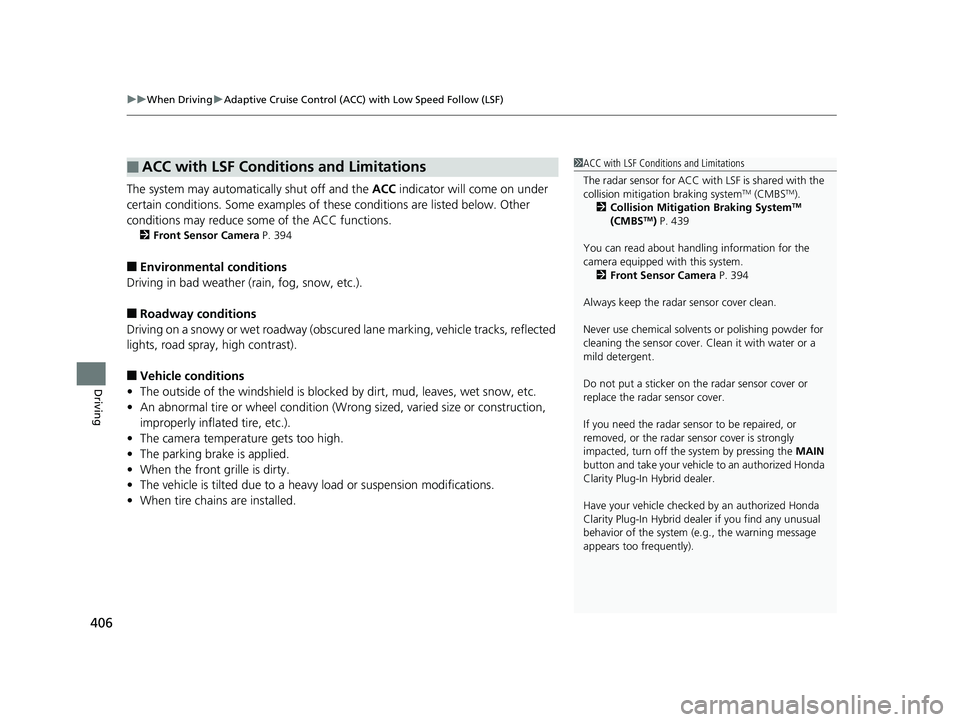
uu When Driving u Adaptive Cruise Control (ACC) with Low Speed Follow (LSF)
406
Driving The system may automatically shut off and the ACC indicator will come on under
certain conditions. Some examples of th ese conditions are listed below. Other
conditions may reduce some of the ACC functions. 2 Front Sensor Camera P. 394
■ Environmental conditions
Driving in bad weather (r ain, fog, snow, etc.).
■ Roadway conditions
Driving on a snowy or wet roadway (obscure d lane marking, vehicle tracks, reflected
lights, road spray, high contrast).
■ Vehicle conditions
• The outside of the windshie ld is blocked by dirt, m ud, leaves, wet snow, etc.
• An abnormal tire or wheel condition (Wrong sized, varied size or construction,
improperly inflated tire, etc.).
• The camera temperature gets too high.
• The parking brake is applied.
• When the front grille is dirty.
• The vehicle is tilted due to a heav y load or suspension modifications.
• When tire chains are installed.■ ACC with LSF Conditions and Limitations 1 ACC with LSF Conditions and Limitations
The radar sensor for ACC with LSF is shared with the
collision mitigation braking system TM
(CMBS TM
).
2 Collision Mitigation Braking System TM
(CMBS TM
) P. 439
You can read about handling information for the
camera equipped with this system.
2 Front Sensor Camera P. 394
Always keep the radar sensor cover clean.
Never use chemical solvents or polishing powder for
cleaning the sensor cover. Clean it with water or a
mild detergent.
Do not put a sticker on the radar sensor cover or
replace the radar sensor cover.
If you need the radar sensor to be repaired, or
removed, or the radar se nsor cover is strongly
impacted, turn off the system by pressing the MAIN
button and take your vehicl e to an authorized Honda
Clarity Plug-In Hybrid dealer.
Have your vehicle checked by an authorized Honda
Clarity Plug-In Hybrid deal er if you find any unusual
behavior of the system (e.g., the warning message
appears too frequently).18 CLARITY PHEV CSS-31TRW6000.book 406 ページ 2017年8月31日 木曜日 午後2時49分
Page 409 of 591

407uu When Driving u Adaptive Cruise Control (ACC) with Low Speed Follow (LSF)
Continued
Driving
■ Detection limitations
• A vehicle or pedestrian suddenly crosses in front of you.
• The interval between your vehicle and the vehicle or pedestrian ahead of you is
too short.
• A vehicle cuts in front of you at a slow speed, and it brakes suddenly.
• When you accelerate rapidly and approach the vehicle or pedestrian ahead of you
at high speed.
• The vehicle ahead of you is a motorcycle, bicycle, mobility scooter, or other small
vehicle.
• When there are animals in front of your vehicle.
• When you drive on a curved or winding or undulating road that makes it difficult
for the sensor to properly detect a vehicle or a pedestrian in front of you.
• The speed difference between your vehicle an d a vehicle or pedestrian in front of
you is significantly large.
• An oncoming vehicle suddenly comes in front of you.
• Your vehicle abruptly crosses over in front of an oncoming vehicle.
• When driving through a narrow iron bridge.
• When the vehicle ahead of you brakes suddenly.
• When the vehicle ahead of you has a unique shape.
• When your vehicle or the vehicle ahead of you is driving on one edge of the lane. 18 CLARITY PHEV CSS-31TRW6000.book 407 ページ 2017年8月31日 木曜日 午後2時49分
Page 414 of 591
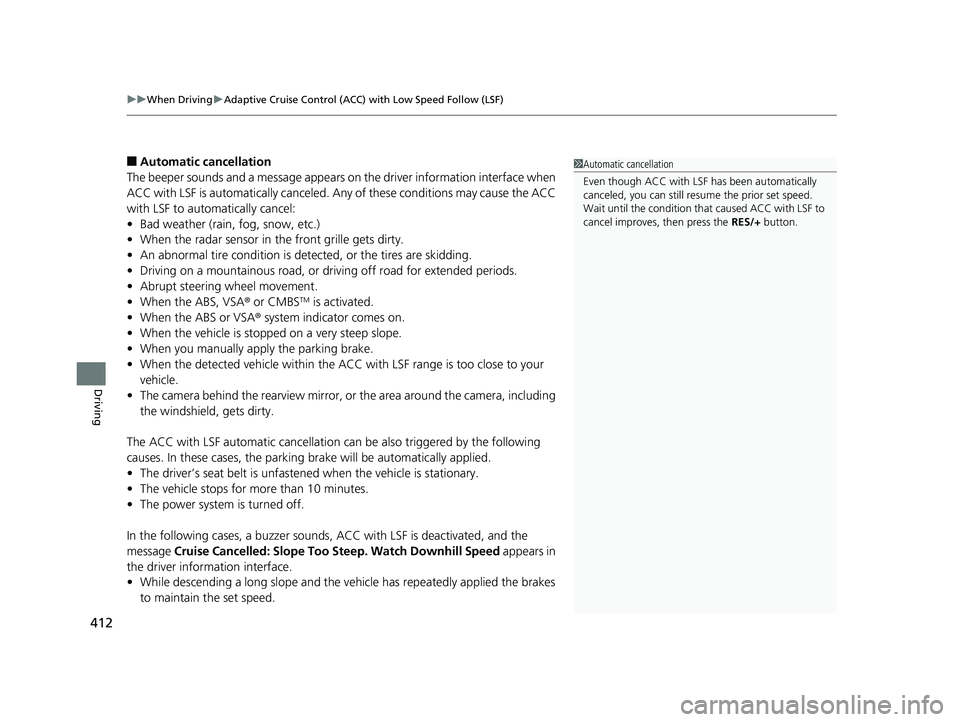
uu When Driving u Adaptive Cruise Control (ACC) with Low Speed Follow (LSF)
412
Driving ■ Automatic cancellation
The beeper sounds and a message appears on the driver information interface when
ACC with LSF is automatically canceled. An y of these conditions may cause the ACC
with LSF to automatically cancel:
• Bad weather (rain, fog, snow, etc.)
• When the radar sensor in the front grille gets dirty.
• An abnormal tire condition is detected, or the tires are skidding.
• Driving on a mountainous road, or driving off road for extended periods.
• Abrupt steering wheel movement.
• When the ABS, VSA ® or CMBS TM
is activated.
• When the ABS or VSA ® system indicator comes on.
• When the vehicle is stopped on a very steep slope.
• When you manually apply the parking brake.
• When the detected vehicle within the ACC with LSF range is too close to your
vehicle.
• The camera behind the rearview mirror, or the area around the camera, including
the windshield, gets dirty.
The ACC with LSF automatic cancellation can be also triggered by the following
causes. In these cases, the parking brake will be automatically applied.
• The driver’s seat belt is unfasten ed when the vehicl e is stationary.
• The vehicle stops for mo re than 10 minutes.
• The power system is turned off.
In the following cases, a buzzer sounds, ACC with LSF is deactivated, and the
message Cruise Cancelled: Slope Too Steep. Watch Downhill Speed appears in
the driver information interface.
• While descending a long slope and the vehi cle has repeatedly applied the brakes
to maintain the set speed. 1 Automatic cancellation
Even though ACC with LSF has been automatically
canceled, you can still resu me the prior set speed.
Wait until the condition that caused ACC with LSF to
cancel improves, then press the RES/+ button.18 CLARITY PHEV CSS-31TRW6000.book 412 ページ 2017年8月31日 木曜日 午後2時49分
Page 417 of 591
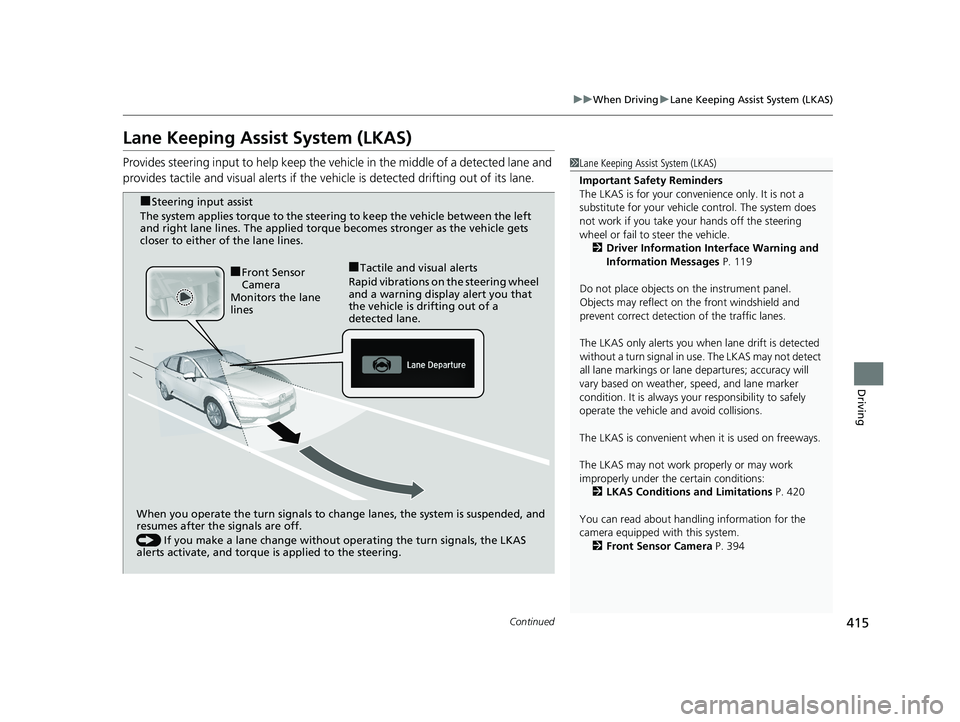
415uu When Driving u Lane Keeping Assist System (LKAS)
Continued
Driving
Lane Keeping Assist System (LKAS) Provides steering input to help keep the vehicle in the middle of a detected lane and
provides tactile and visual al erts if the vehicle is detected drifting out of its lane. 1 Lane Keeping Assist System (LKAS)
Important Safety Reminders
The LKAS is for your convenience only. It is not a
substitute for your vehicl e control. The system does
not work if you take y our hands off the steering
wheel or fail to steer the vehicle.
2 Driver Information Interface Warning and
Information Messages P. 119
Do not place objects on the instrument panel.
Objects may reflect on th e front windshield and
prevent correct detectio n of the traffic lanes.
The LKAS only alerts you wh en lane drift is detected
without a turn signal in us e. The LKAS may not detect
all lane markings or lane departures; accuracy will
vary based on weather, speed, and lane marker
condition. It is always your responsibility to safely
operate the vehicle an d avoid collisions.
The LKAS is convenient when it is used on freeways.
The LKAS may not work properly or may work
improperly under the certain conditions:
2 LKAS Conditions and Limitations P. 420
You can read about handling information for the
camera equipped with this system.
2 Front Sensor Camera P. 394When you operate the turn signals to chan ge lanes, the system is suspended, and
resumes after the signals are off.
() If you make a lane change without operating the turn signals, the LKAS
alerts activate, and torque is applied to the steering.■ Front Sensor
Camera
Monitors the lane
lines
■ Tactile and visual alerts
Rapid vibrations on the steering wheel
and a warning display alert you that
the vehicle is drifting out of a
detected lane.■ Steering input assist
The system applies torque to the steering to keep the vehicle between the left
and right lane lines. The applied torque becomes stronger as the vehicle gets
closer to either of the lane lines.18 CLARITY PHEV CSS-31TRW6000.book 415 ページ 2017年8月31日 木曜日 午後2時49分
Page 441 of 591
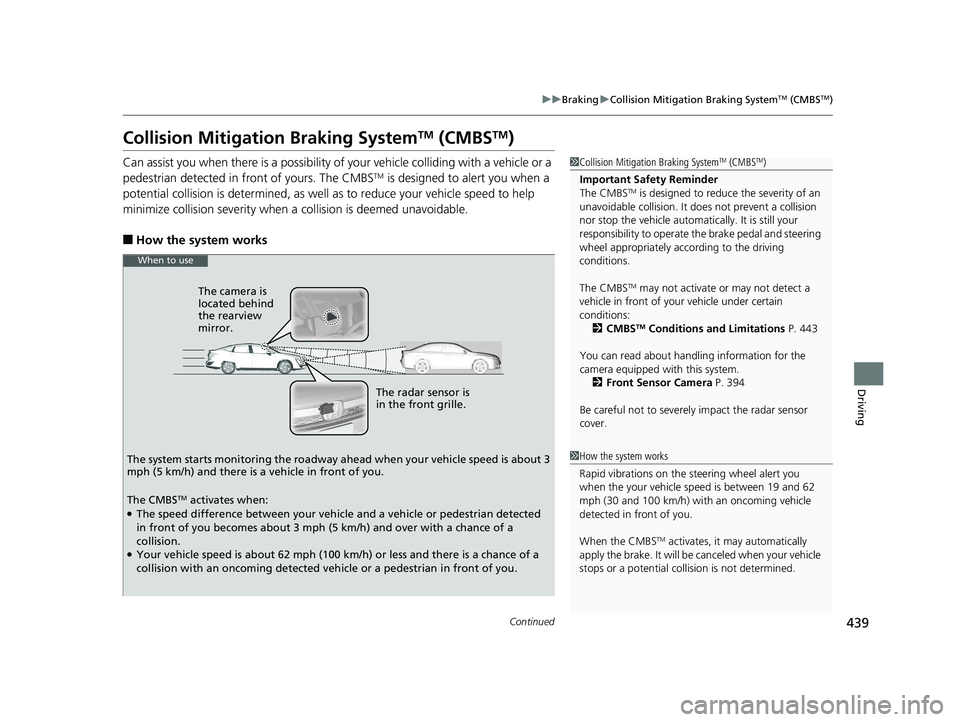
439uu Braking u Collision Mitigation Braking System TM
(CMBS TM
)
Continued
Driving
Collision Mitigation Braking System TM
(CMBS TM
)Can assist you when there is a possibility of your vehicle colliding with a vehicle or a
pedestrian detected in front of yours. The CMBS TM
is designed to alert you when a
potential collision is determined, as well as to reduce your vehicle speed to help
minimize collision severity when a collision is deemed unavoidable.
■ How the system works 1 Collision Mitigation Braking System TM
(CMBS TM
)
Important Safety Reminder
The CMBS TM
is designed to reduce the severity of an
unavoidable collision. It do es not prevent a collision
nor stop the vehicle automati cally. It is still your
responsibility to operate the brake pedal and steering
wheel appropriately acco rding to the driving
conditions.
The CMBS TM
may not activate or may not detect a
vehicle in front of y our vehicle under certain
conditions:
2 CMBS TM
Conditions and Limitations P. 443
You can read about handling information for the
camera equipped with this system.
2 Front Sensor Camera P. 394
Be careful not to severely impact the radar sensor
cover.
1 How the system works
Rapid vibrations on the steering wheel alert you
when the your vehicle speed is between 19 and 62
mph (30 and 100 km/h) with an oncoming vehicle
detected in front of you.
When the CMBS TM
activates, it may automatically
apply the brake. It will be canceled when your vehicle
stops or a potential coll ision is not determined.The radar sensor is
in the front grille.The camera is
located behind
the rearview
mirror.
The system starts monitoring the roadway ah ead when your vehicle speed is about 3
mph (5 km/h) and there is a vehicle in front of you. When to use
The CMBS TM
activates when: ●
The speed difference between your vehicle and a vehicle or pedestrian detected
in front of you becomes about 3 mph (5 km/h) and over with a chance of a
collision. ●
Your vehicle speed is about 62 mph (100 km/h) or less and there is a chance of a
collision with an oncoming detected ve hicle or a pedestrian in front of you.18 CLARITY PHEV CSS-31TRW6000.book 439 ページ 2017年8月31日 木曜日 午後2時49分
Page 443 of 591
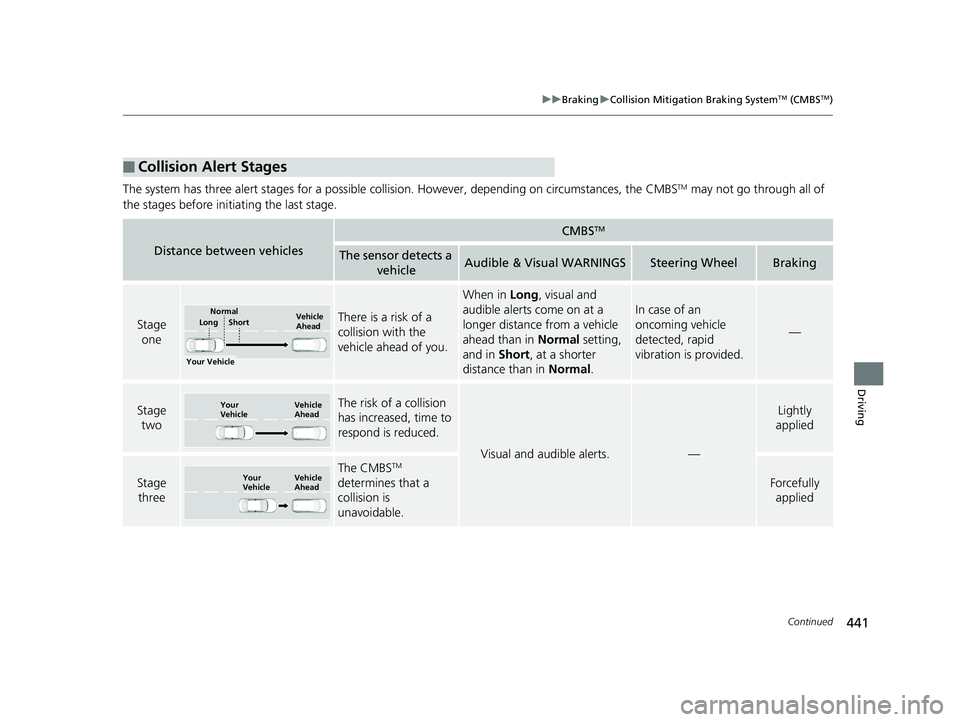
441uu Braking u Collision Mitigation Braking System TM
(CMBS TM
)
Continued
Driving
The system has three alert stages for a possible collis ion. However, depending on circumstances, the CMBS TM
may not go through all of
the stages before initiating the last stage.
■ Collision Alert Stages Distance between vehicles CMBS TM
The sensor detects a
vehicle Audible & Visual WARNINGS Steering Wheel Braking
Stage
one There is a risk of a
collision with the
vehicle ahead of you. When in Long , visual and
audible alerts come on at a
longer distance from a vehicle
ahead than in Normal setting,
and in Short , at a shorter
distance than in Normal . In case of an
oncoming vehicle
detected, rapid
vibration is provided. —
Stage
two The risk of a collision
has increased, time to
respond is reduced.
Visual and audible alerts. — Lightly
applied
Stage
three The CMBS TM
determines that a
collision is
unavoidable. Forcefully
appliedYour Vehicle Vehicle
AheadShortLong Normal
Your
Vehicle Vehicle
Ahead
Your
Vehicle Vehicle
Ahead18 CLARITY PHEV CSS-31TRW6000.book 441 ページ 2017年8月31日 木曜日 午後2時49分
Page 445 of 591
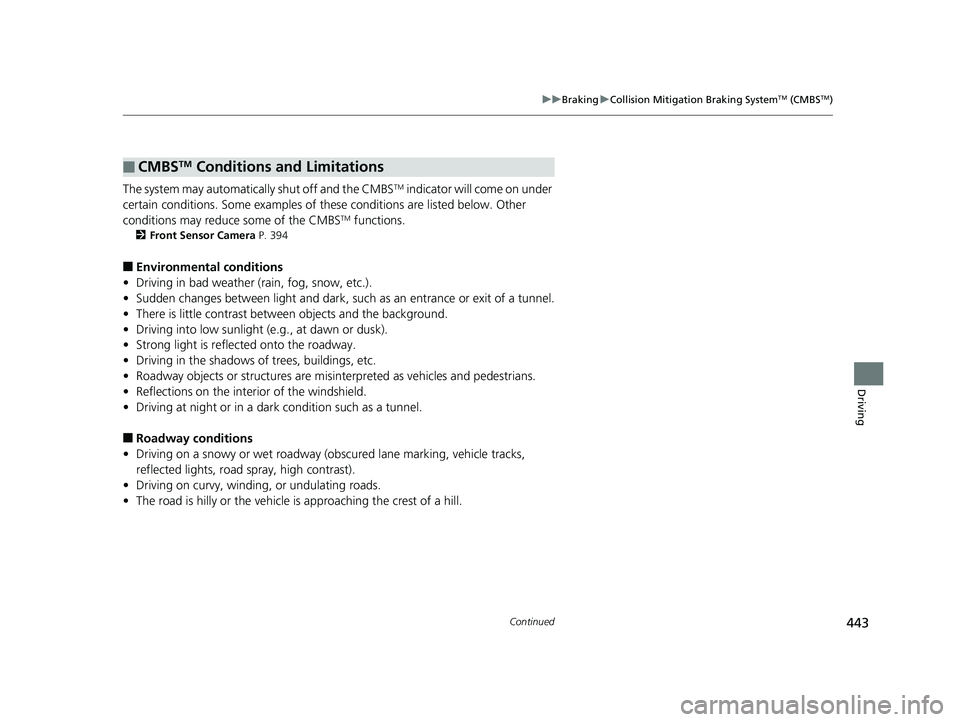
443uu Braking u Collision Mitigation Braking System TM
(CMBS TM
)
Continued
Driving
The system may automatically shut off and the CMBS TM
indicator will come on under
certain conditions. Some examples of thes e conditions are listed below. Other
conditions may reduce some of the CMBS TM
functions.2 Front Sensor Camera P. 394
■ Environmental conditions
• Driving in bad weather (rain, fog, snow, etc.).
• Sudden changes between light and dark, such as an entrance or exit of a tunnel.
• There is little contrast between objects and the background.
• Driving into low sunlight (e.g., at dawn or dusk).
• Strong light is reflec ted onto the roadway.
• Driving in the shadows of trees, buildings, etc.
• Roadway objects or structures are misint erpreted as vehicles and pedestrians.
• Reflections on the interi or of the windshield.
• Driving at night or in a dark condition such as a tunnel.
■ Roadway conditions
• Driving on a snowy or wet roadway (obs cured lane marking, vehicle tracks,
reflected lights, road spray, high contrast).
• Driving on curvy, winding, or undulating roads.
• The road is hilly or the vehicle is approaching the crest of a hill.■ CMBS TM
Conditions and Limitations18 CLARITY PHEV CSS-31TRW6000.book 443 ページ 2017年8月31日 木曜日 午後2時49分
Page 446 of 591
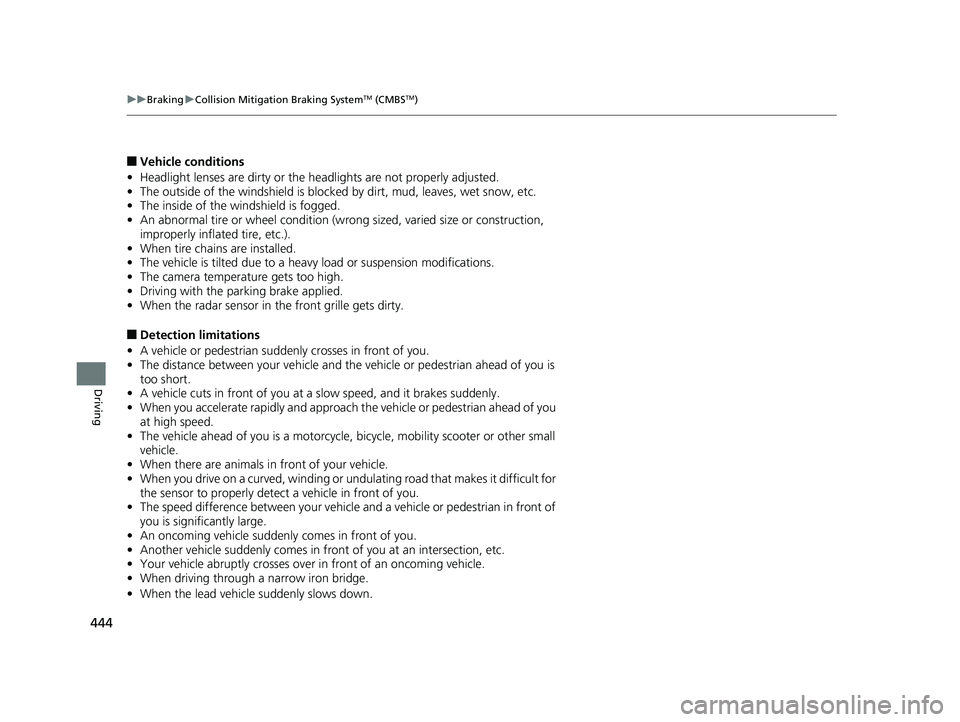
444 uu Braking u Collision Mitigation Braking System TM
(CMBS TM
)
Driving ■ Vehicle conditions
• Headlight lenses are dirty or the headlights are not properly adjusted.
• The outside of the windshie ld is blocked by dirt, m ud, leaves, wet snow, etc.
• The inside of the windshield is fogged.
• An abnormal tire or wheel condition (wrong sized, varied size or construction,
improperly inflated tire, etc.).
• When tire chains are installed.
• The vehicle is tilted due to a heav y load or suspension modifications.
• The camera temperature gets too high.
• Driving with the parking brake applied.
• When the radar sensor in the front grille gets dirty.
■ Detection limitations
• A vehicle or pedestrian suddenly crosses in front of you.
• The distance between your vehicle and the vehicle or pedestrian ahead of you is
too short.
• A vehicle cuts in front of you at a slow speed, and it brakes suddenly.
• When you accelerate rapidly and approach the vehicle or pedestrian ahead of you
at high speed.
• The vehicle ahead of you is a motorcycle, bicycle, mobility scooter or other small
vehicle.
• When there are animals in front of your vehicle.
• When you drive on a cu rved, winding or undu lating road that makes it difficult for
the sensor to properly detect a vehicle in front of you.
• The speed difference between your vehicle an d a vehicle or pedestrian in front of
you is significantly large.
• An oncoming vehicle suddenly comes in front of you.
• Another vehicle suddenly comes in front of you at an intersection, etc.
• Your vehicle abruptly crosses over in front of an oncoming vehicle.
• When driving through a narrow iron bridge.
• When the lead vehicle suddenly slows down. 18 CLARITY PHEV CSS-31TRW6000.book 444 ページ 2017年8月31日 木曜日 午後2時49分
Page 448 of 591

uu Braking u Collision Mitigation Braking System TM
(CMBS TM
)
446
Driving The CMBS TM
may activate even when you are aw are of a vehicle ahead of you, or
when there is no vehicle ahead . Some examples of this are:
■ When Passing
Your vehicle approaches another vehicle ah ead of you and you change lanes to pass.
■ At an intersection
Your vehicle approaches or passes another vehicle that is making a left or right turn.
■ On a curve
When driving through curves, your vehicle comes to a point where an oncoming
vehicle is right in front of you.
■ Through a low bridge at high speed
You drive under a low or narrow bridge at high speed.
■ Speed bumps, road work sites, tr ain tracks, roadside objects, etc.
You drive over speed bumps, st eel road plates, etc., or yo ur vehicle approaches train
tracks or roadside objects [such as a traffi c sign and guard rail] on a curve or, when
parking, stationary vehicles and walls.■ With Little Chance of a Collision 1 Collision Mitigation Braking System TM
(CMBS TM
)
For the CMBS TM
to work properly:
Always keep the radar sensor cover clean.
Never use chemical solvents or polishing powder for
cleaning the sensor cover. Clean it with water or a
mild detergent.
Do not apply any coverings or paint to the radar
sensor area. Do not put a sticker on the emblem or
replace the emblem.
These can impact CMBS TM
operation.
If you need the radar sensor to be repaired, or
removed, or the radar se nsor cover is strongly
impacted, turn off the system by pressing the
CMBS TM
off button and take your vehicle to an
authorized Honda Clarity Plug-In Hybrid dealer.
Have your vehicle checked by an authorized Honda
Clarity Plug-In Hybrid deal er if you find any unusual
behavior of the system (e.g., the warning message
appears too frequently).
If the front of the vehicle is impacted in any of the
following situations, the ra dar sensor may not work
properly. Have your vehicle checked by an authorized
Honda Clarity Plug-In Hybrid dealer:
• The vehicle mounted onto a bump, curb, chock,
embankment, etc.
• You drive the vehicle where the water is deep.
• Your vehicle has a frontal collision.18 CLARITY PHEV CSS-31TRW6000.book 446 ページ 2017年8月31日 木曜日 午後2時49分
Page 510 of 591
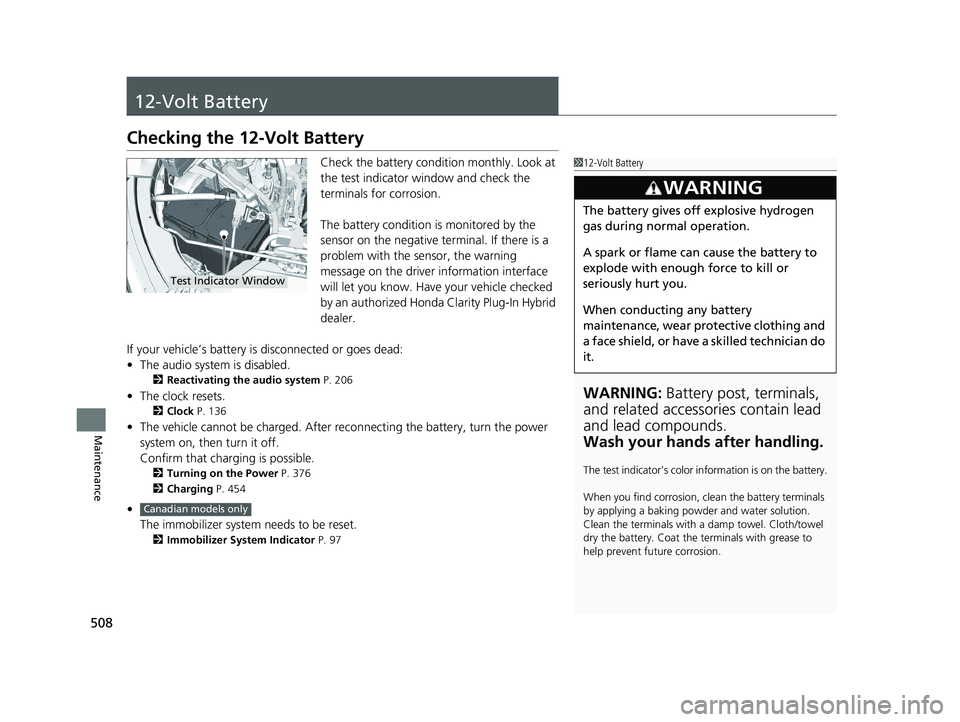
508
Maintenance 12-Volt Battery Checking the 12-Volt Battery Check the battery condition monthly. Look at
the test indicator window and check the
terminals for corrosion.
The battery condition is monitored by the
sensor on the negative terminal. If there is a
problem with the sensor, the warning
message on the driver information interface
will let you know. Have your vehicle checked
by an authorized Honda Clarity Plug-In Hybrid
dealer.
If your vehicle’s battery is disconnected or goes dead:
• The audio system is disabled. 2 Reactivating the audio system P. 206
• The clock resets. 2 Clock P. 136
• The vehicle cannot be charged. After re connecting the batte ry, turn the power
system on, then turn it off.
Confirm that charging is possible. 2 Turning on the Power P. 376
2 Charging P. 454
•
The immobilizer system needs to be reset. 2 Immobilizer System Indicator P. 97 1 12-Volt Battery
WARNING: Battery post, terminals,
and related accessories contain lead
and lead compounds.
Wash your hands after handling. The test indicator’s color in formation is on the battery.
When you find corrosion, cl ean the battery terminals
by applying a baking powder and water solution.
Clean the terminals with a damp towel. Cloth/towel
dry the battery. Coat the terminals with grease to
help prevent future corrosion.3
WARNING The battery gives off explosive hydrogen
gas during normal operation.
A spark or flame can cause the battery to
explode with enough force to kill or
seriously hurt you.
When conducting any battery
maintenance, wear prot ective clothing and
a face shield, or have a skilled technician do
it.Test Indicator Window
Canadian models only18 CLARITY PHEV CSS-31TRW6000.book 508 ページ 2017年8月31日 木曜日 午後2時49分